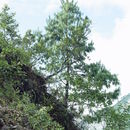Description
provided by eFloras
Trees to 25 m or more; crown moderately open, not twiggy; branches spreading, drooping, sinuous; 1st-year branchlets conspicuously whitish bloomed, glandular pubescent; 2nd-year branchlets with thin, pale gray-green bark. Needles shed in 2nd year, 5 per bundle, pendulous, very slender, curved, triangular in cross section, 15-24 cm, adaxial surface grass green with no stomata, 2 abaxial surfaces conspicuously whitish bloomed, each with 4-7 stomatal lines, resin canals 3(or 4), adaxial 2 marginal or submarginal, abaxial 1(or 2) marginal or submarginal and always asymmetrically placed. Seed cones pedunculate (peduncle (1-) 4.5-6 cm), elongate-cylindric, 12-20 × 3-4 cm (5-7 cm wide when open). Seed scales rather elongate, thinly woody, base cuneate; apophyses rhombic, 1-1.5 × 1.5-2.5 cm, keeled, apex subacute. Seeds brown, obovoid, compressed, 6-8 × 4-5 mm; wing persistent, ca. 2 × 0.7-1 cm.
- license
- cc-by-nc-sa-3.0
- copyright
- Missouri Botanical Garden, 4344 Shaw Boulevard, St. Louis, MO, 63110 USA
Habitat & Distribution
provided by eFloras
SE Xizang [Bhutan]
- license
- cc-by-nc-sa-3.0
- copyright
- Missouri Botanical Garden, 4344 Shaw Boulevard, St. Louis, MO, 63110 USA
Distribution
provided by Plants of Tibet
Pinus bhutanica is occurring in SE Xizang, NW Yunnan of China, NE India, Bhutan.
Evolution
provided by Plants of Tibet
A new classification for the Pinus was proposed based on the cpDNA sequences (matK and rbcL), nuclear ribosomal DNA and morphology (Gernandt et al., 2005). In there, Pinus bhutanica belong to subgenus Strobus, section Strobus, subsection Strobus.
General Description
provided by Plants of Tibet
Trees to 25 m or more; crown moderately open, not twiggy; branches spreading, drooping, sinuous; 1st-year branchlets conspicuously whitish bloomed, glandular pubescent; 2nd-year branchlets with thin, pale gray-green bark. Needles shed in 2nd year, 5 per bundle, pendulous, very slender, curved, triangular in cross section, 15-24 cm, adaxial surface grass green with no stomata, 2 abaxial surfaces conspicuously whitish bloomed, each with 4-7 stomatal lines, resin canals 3 or 4, adaxial 2 marginal or submarginal, abaxial 1 or 2 marginal or submarginal and always asymmetrically placed. Seed cones pedunculate 4.5-6 cm, elongate-cylindric, 12-20 cm long, 3-4 cm wide (5-7 cm wide when open). Seed scales rather elongate, thinly woody, base cuneate; apophyses rhombic, 1-1.5 cm long, 1.5-2.5 cm wide, keeled, apex subacute. Seeds brown, obovoid, compressed, 6-8 mm long, 4-5 mm wide; wing persistent, ca. 2 cm long, 0.7-1 cm wide.
Habitat
provided by Plants of Tibet
Growing in forest; 1000-2500 m.
Threats
provided by Plants of Tibet
Pinus bhutanica is reported be least concern (Bachman et al., 2007).
Pinus bhutanica
provided by wikipedia EN
Pinus bhutanica, which may be called the Bhutan white pine, is a tree restricted to Bhutan and adjacent parts of northeast India (Arunachal Pradesh) and southwest China (Yunnan and Tibet).[1] Along with the related Pinus wallichiana it is a constituent of lower altitude blue pine forests. This pine reaches a height of 25 meters. Note that P. wallichiana is sometimes called by the common name 'Bhutan pine'.
The needles are in bundles of five, up to 25 cm long. The cones are 12–20 cm in length, with thin scales; the seeds are 5–6 mm long, with a 20–25 mm wing. It differs from P. wallichiana in the much longer, strongly drooping needles, and the cones being slightly smaller and red-brown, rather than yellow-buff, when mature. It is also adapted to generally warmer, wetter climates at lower altitudes, with an intense summer monsoon. Despite the two being closely related and at least occasionally growing together, no hybrids or intermediates have ever been reported.
References
- license
- cc-by-sa-3.0
- copyright
- Wikipedia authors and editors
Pinus bhutanica: Brief Summary
provided by wikipedia EN
Pinus bhutanica, which may be called the Bhutan white pine, is a tree restricted to Bhutan and adjacent parts of northeast India (Arunachal Pradesh) and southwest China (Yunnan and Tibet). Along with the related Pinus wallichiana it is a constituent of lower altitude blue pine forests. This pine reaches a height of 25 meters. Note that P. wallichiana is sometimes called by the common name 'Bhutan pine'.
The needles are in bundles of five, up to 25 cm long. The cones are 12–20 cm in length, with thin scales; the seeds are 5–6 mm long, with a 20–25 mm wing. It differs from P. wallichiana in the much longer, strongly drooping needles, and the cones being slightly smaller and red-brown, rather than yellow-buff, when mature. It is also adapted to generally warmer, wetter climates at lower altitudes, with an intense summer monsoon. Despite the two being closely related and at least occasionally growing together, no hybrids or intermediates have ever been reported.
- license
- cc-by-sa-3.0
- copyright
- Wikipedia authors and editors

